"The Greatest Living American” Returns to Cumberland
Theodore Roosevelt Makes Last Appeal to Maryland Voters
“Let the People Rule!”
By Champ Zumbrun
In 1912, Colonel Theodore Roosevelt threw his “hat in the ring” to run for a third term as President of the United States. Saturday, May 4, 1912 found Republican candidate Theodore Roosevelt spending the last day of his Maryland campaign on a train touring western Maryland before that state’s primary vote on Monday. Roosevelt began his whirlwind journey that day from Baltimore after giving a rousing speech the night before at the Lyric Theater.
Leaving on a train from Baltimore at 7:55 a.m., Roosevelt entourage headed toward Westminster. Standing on a platform erected near the train depot, TR gave a 25-minute address to the Westminster crowd of 1,500 people. When an ongoing dogfight in sight of the platform delayed the beginning of Roosevelt’s speech TR merely smiled saying, “we will wait till the fight is over, and then we will begin.” This canine clash perhaps foretold the upcoming battle about to occur at the Republican Convention in June when republicans fought a vicious fight to select a presidential candidate to run in the general election against the democrats.
Standing near the platform was Captain Wigl, a roughrider who had served under Roosevelt in Cuba. When Roosevelt completed his speech Wigl pressed forward to talk to the Colonel. Roosevelt, remembering Wigl’s service, greeted the former soldier with great enthusiasm
The towns of Glyndon, New Windsor, Union Bridge, Keymar, and Walkersville were also on Roosevelt’s morning route. Roosevelt stopped briefly in these smaller hamlets on what turned out to be a beautiful spring day. Here TR, from his position standing on the platform of the rear car of the train, spoke a few words and shook hands.
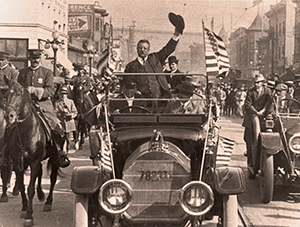 Roosevelt’s train arrived 11:22 am at the Frederick train station. The town had made a holiday out of Roosevelt’s visit. A band, a squad of mounted men, and a company of Boy Scouts met Roosevelt at the depot. A parade took “Colonel Roosevelt through the City to the park in front of the Court House where he spoke" to an estimated ten thousand people. During the parade, a band played in front of Colonel Roosevelt’s automobile and another behind it, both playing different tunes at the same time. Not musically inclined, Roosevelt said it made no difference to him if he heard two different songs playing at once since “Garryowen” was the only music he knew. A newspaper reported that the two bands continued to “fight it out until the parade was over and were still at it and when Roosevelt’s train rolled away.”
Roosevelt’s train arrived 11:22 am at the Frederick train station. The town had made a holiday out of Roosevelt’s visit. A band, a squad of mounted men, and a company of Boy Scouts met Roosevelt at the depot. A parade took “Colonel Roosevelt through the City to the park in front of the Court House where he spoke" to an estimated ten thousand people. During the parade, a band played in front of Colonel Roosevelt’s automobile and another behind it, both playing different tunes at the same time. Not musically inclined, Roosevelt said it made no difference to him if he heard two different songs playing at once since “Garryowen” was the only music he knew. A newspaper reported that the two bands continued to “fight it out until the parade was over and were still at it and when Roosevelt’s train rolled away.”
The barnstorming tour continued from Frederick, the train next stopping at Brunswick for five minutes. From the rear railroad car TR spoke to an estimated 1,000 people. He told the people of Brunswick that he intended to “fight for the laboring man,” the contest being between “the common people and the professional politicians.” If elected Roosevelt promised to work on an “employees compensation act.”
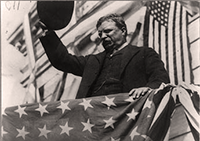 Roosevelt’s train arrived at the Hagerstown train station at 2:30 pm. From here, officials whisked the Colonel off to the Hagerstown County Fairgrounds where he spoke. The grandstand contained enough seats for 6,000 persons but this was not large enough for the crowd that turned out. Colonel Roosevelt climbed on a table placed upon a platform in front of the grandstand in an attempt to bring in as large a part of the crowd as possible within range of his voice.
Roosevelt’s train arrived at the Hagerstown train station at 2:30 pm. From here, officials whisked the Colonel off to the Hagerstown County Fairgrounds where he spoke. The grandstand contained enough seats for 6,000 persons but this was not large enough for the crowd that turned out. Colonel Roosevelt climbed on a table placed upon a platform in front of the grandstand in an attempt to bring in as large a part of the crowd as possible within range of his voice.
Throughout the whistle stop tour Roosevelt received accolade after accolade from officials who introduced him to the crowd. Arriving at Hancock around 4 pm, a dignitary introduced TR as “the greatest ex-president living.” In another town, a notable person presented TR as the “greatest living American,” and yet at another stop, a politician heralded Roosevelt as “the real thing … the greatest human being who ever trod the earth!
The Western Maryland Railroad # 3 took Roosevelt westward paralleling the Chesapeake & Ohio Canal. The entourage passed over the bridge at Little Orleans, onward through Mertens Apple Orchard at present day Green Ridge State Forest. The Appalachians were looking especially grand from Roosevelt’s private car as the former President observed thousands of apple trees in bloom along the route. From here Roosevelt passed through Oldtown before arriving at 7 pm at the Cumberland Western Maryland Railroad Station.
A delegation headed by a brass band greeted the distinguished visitor. In this reception party were former United States Senator George L. Wellington, former Congressman George Pearre, and Senator F. N. Zilman. Roosevelt briskly stepped off the train and made his way into a waiting automobile.
Like the city of Frederick, Cumberland also made a holiday out of Roosevelt’s visit to their town, organizing a parade and making a great event of the occasion. The streets of Cumberland were "lit up on fire.” A brass band headed a procession from the Western Maryland Railroad to the Queen City Station where Roosevelt took time for dinner. Roosevelt was “clad in a dark gray traveling suit. His crisp curly hair, now silvering on the sides, was capped by a wide black slouch hat.” Great numbers of people gathered along the parade route. All along the way to Queen City Station, Roosevelt stood in the automobile waving his hat, bowing to the crowd, and flashing his famous smile known throughout the world.
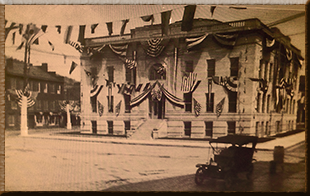
After dinner, officials transported Roosevelt to the newly constructed Cumberland City Hall on Liberty Street. People had gathered at the train station and at the City hall town square hours before the arrival of TR’s train. Thousands of people in attendance filled every space in the proximity of City Hall and crammed every window facing City Hall.
Organizers had decorated the walls on the outside of City Hall in national colors -- truly making this event a grand spectacle. Former U.S. Senator George L. Wellington introduced Roosevelt at Cumberland. Wellington began by saying, “I am about to introduce now an ex-police commissioner of New York; … an ex-governor of New York; … an ex-soldier of the United States; … an ex-vice president of the United States; … an ex-President of the United States, and who I believe will be the next President of the United States –Colonel Theodore Roosevelt!”
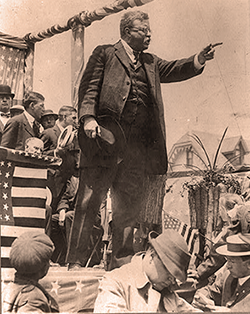 Roosevelt appeared before the “monster mass meeting” at 8:15 pm standing on the bed of Mr. Hirshman’s “auto-truck” that was also decorated in national and Maryland colors. Organizers of the event shoved the vehicle against the side of City Hall near the steps on the Liberty Street side of the building facing the public square. Officials believed this throng of people was the largest crowd assembled since William Jennings Bryan spoke in Cumberland in 1908
Roosevelt appeared before the “monster mass meeting” at 8:15 pm standing on the bed of Mr. Hirshman’s “auto-truck” that was also decorated in national and Maryland colors. Organizers of the event shoved the vehicle against the side of City Hall near the steps on the Liberty Street side of the building facing the public square. Officials believed this throng of people was the largest crowd assembled since William Jennings Bryan spoke in Cumberland in 1908
Reporters stated that Roosevelt was at his best this evening as he spoke as a “lecturer, special pleader, preacher, and fiery denunciator.” Here, Roosevelt presented his final appeal to the state’s voters before the Maryland primaries.
TR emphasized that western Maryland was the stronghold of the Republican Party and a region known for its farmers, miners, and hard working men. He asked his “friends” to remember the patriotic deeds of the founding fathers and noble sacrifices of their ancestors. If people still valued these ideals then they must cast their vote to support those principles. He insisted stop after stop that the “right of the people to rule” [was] “the greatest fundamental issue now before the Republican party and before our people.” Within a few months TR shortened this statement to a new campaign slogan, “Let the People Rule.”
At each town Roosevelt proudly reminded crowds of his accomplishments when he last held the office of President between the years of 1901-1909, comparing his virtues to his rival and current sitting President, William Howard Taft. Indeed, they were many significant successes on which to brag. For example, under his administration as President and conservation crusader, Roosevelt established or enlarged 150 national forests; 51 bird reservations; 4 national game preserves; 6 national parks; and 18 national monuments.
TR said the system was rigged against him emphasizing that both political and corporate leaders saw their downfall if Roosevelt won the election. The Colonel noted that both Republican and Democratic parties had marching orders to work together against him. "Federal office holders” were getting aid from Roosevelt’s opponents and “if the people did not drive the bosses from power they must expect to get the worst of the bargain.” He said that the “silk-stocking’ class would do everything they could do to thwart the will of the “plain people.” Roosevelt then asked the crowd, "Isn't that so?"
A man responded in the crowd in a loud voice "There're doing it here!"
The crowd responded in an uproar of shouts and cheers that included “thousands” of miners. When the noise finally began to settle down Roosevelt responded: "Exactly! I knew it! It’s the same from the Atlantic to the Pacific all over the Country."
TR softened somewhat saying he did “not mean all the men against him were bad men, knowing that there were “multitudes of well-meaning men against” him and his followers who were not aware of the issues. “Nine-tenths of wisdom is being wise at [the right time]," Roosevelt said.
Roosevelt concluded his speech warning his followers to look for fraud at the voting booths. "Our opponents know how to manipulate the returns, you watch them carefully,” he said. “There are people who know how to do the bribing. See to it that you don't let your opponents win by treachery. I don't think there any people on our side that will give a bribe, but if you find any such a one, I want you to try and put him in the penitentiary, and I will help you!"
After speaking for an hour and finishing a tumultuous day of “stumping” in Maryland, Roosevelt departed Cumberland. Leaving from Queen City Station, TR traveled on the Baltimore & Ohio Railroad toward his home at Oyster Bay, New York.
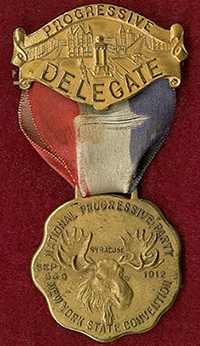 Roosevelt won the Republican Maryland primary by a thin margin. However, both Roosevelt and Taft were short of the required number of delegates needed for nomination as the Republican presidential candidate at their National Convention. Delegates ultimately selected Taft at the convention as their Republican presidential candidate. Instead of dropping out, Theodore Roosevelt then ran as third party candidate in the Progressive Bull Moose party. Democratic candidate Woodrow Wilson won the general election on November 5, 1912, benefitting from a divided republican party. Wilson received 435 electoral votes and 42 percent of the popular vote; Roosevelt received 88 electoral votes and 27 percent of the popular vote; and Taft received 8 electoral votes and 23 percent of the popular vote.
Roosevelt won the Republican Maryland primary by a thin margin. However, both Roosevelt and Taft were short of the required number of delegates needed for nomination as the Republican presidential candidate at their National Convention. Delegates ultimately selected Taft at the convention as their Republican presidential candidate. Instead of dropping out, Theodore Roosevelt then ran as third party candidate in the Progressive Bull Moose party. Democratic candidate Woodrow Wilson won the general election on November 5, 1912, benefitting from a divided republican party. Wilson received 435 electoral votes and 42 percent of the popular vote; Roosevelt received 88 electoral votes and 27 percent of the popular vote; and Taft received 8 electoral votes and 23 percent of the popular vote.
Theodore Roosevelt in Maryland
 When as New York Governor, Roosevelt visited western Maryland in 1899 while he was campaigning for Governor Lowndes and President McKinley. It was on this tour that TR witnessed first- hand the devastation of Maryland forests. Not long after this visit to western Maryland, possibly under the political influence of Roosevelt, who was still vigorously campaigning for the reelection of President McKinley, in 1900 the U. S Forest Service conducted the first scientific forest inventory in Maryland in Allegany County.
When as New York Governor, Roosevelt visited western Maryland in 1899 while he was campaigning for Governor Lowndes and President McKinley. It was on this tour that TR witnessed first- hand the devastation of Maryland forests. Not long after this visit to western Maryland, possibly under the political influence of Roosevelt, who was still vigorously campaigning for the reelection of President McKinley, in 1900 the U. S Forest Service conducted the first scientific forest inventory in Maryland in Allegany County.
In May 1902 Roosevelt, now President of the United States, sent Gifford Pinchot, Chief of the United States Forest Service”, along with Edith Roosevelt, the First Lady, and Theodore Roosevelt Jr., Teddy’s and Edith’s fifteen-year-old son to Garrett County, Maryland. This distinguished party arrived at Oakland, MD on the B&O Railroad. From here, Pinchot and his companions traveled ten miles to McHenry where they stayed at a lodge along Deep Creek owned by Gus W. Delawder, former “Elected Head” of Oakland (1879), who worked as an agent for the B&O Railroad and also served as the Commissioner of Fisheries for Maryland. Pinchot and Delawder were kindred spirits, for like the chief forester, Gus was “a noted authority on game and fish and a most successful angler and hunter.” During his stay with Delawder, Pinchot, “the Father of American Forestry” must have observed the forest devastation that Roosevelt had witnessed earlier.
In 1906, the State of Maryland was the third state in the country to establish a “State Board of Forestry” to oversee the management of the forestland. Pinchot handpicked one of his federal field foresters, Fred W. Besley, to serve as Maryland's first State Forester. Because Pinchot paid part of Besley’s salary, Pinchot had a say regarding who worked in the Maryland State Forester position.
During his visit to Maryland in 1912, Roosevelt must have been somewhat pleased of the progress of forest conservation in Maryland. Not only was a State Board of Forestry established in Maryland, two forest reserves consisting together of approximately 4,000 acres had also been established – Garrett State Forest Reserve and Patapsco State Forest Reserve.
Sources:
Brinkley, Douglas. The Wilderness Warrior: Theodore Roosevelt and the Crusade for America. New York, NY: Harper, 2009. pp. 818-830.
"Colonel Roosevelt in Cumberland: Great Crowds Gather to See U.S. President at 7:00 Saturday." Cumberland Evening Times 6 May 1912: 1, 10.
Cowan, Geoffrey. Let The People Rule" Theodore Roosevelt and the Birth of the Presidential Primary. New York / London: W.W. Norton & Comapany, 2016. pp. 2, 166, 343
Daily Review 5 May 1912: 1.
Goodwin, Doris Kearns. The Bully Pulpit: Theodore Roosevelt, William Howard Taft and the Golden Age of Journalism. New York, NY: Simon & Schuster , 2013.
"Roosevelt Appeals to the People." Greensboro Dailey News 5 May 1912.
"Roosevelt is Greeted by Throng at the Court House; Colonel Passes an Hour in Frederick - Makes a Speech in Which He Was Charged that He Preached Anarchy; Says What He Does Preach is the 'Man Above The Dollar;' He Rises in Auto to Wave to the Children ." Frederck Post 4 May 1912: 1,5.
"Roosevelt in Tour Of Maryland Assails Crooks of Both Parties." Washington Herald 1912 5 May 1912.
"Roosevelt To Be Here Tonight: Colonel Will Make Speech in Public Square." Cumberland Evening TImes 4 May 1912: 1.
Schlosnagle, Stephen. Garrett County: A History of Maryland's Tableland. Oakland, MD: Garrett County Historical Society, 1997. This book covers Pinchot’s visit to Garrett County in 1902.
“Very Rough Riding; Of the Roosevelt-Lowndes Tour in this County.” Cumberland Evening Times, October 25, 1899. pp.1, 4.
Zumbrun, Champ. A History of Green Ridge State Forest . Charleston, South Carolinina: History Press, 2010.This book covers the first scientific forest inventory in Maryland in Allegany County and includes a brief biography of Fred W. Besley’s forestry career in Maryland.
Photographs:
Cumberland City Hall in 1912 taken by Russell C. Paupe (1886-1976) and courtesy of Andrew Sparber.
Theodore Roosevelt on the campain trail in 1912, Public Domain.
Teddy Roosevelt's 1912 Bull Moose Convention Medallion, From the collection of Albert Louis Feldstein.
Note: An excerpt of this article was previously published in the the November 2016 edition of Allegany Magazine.